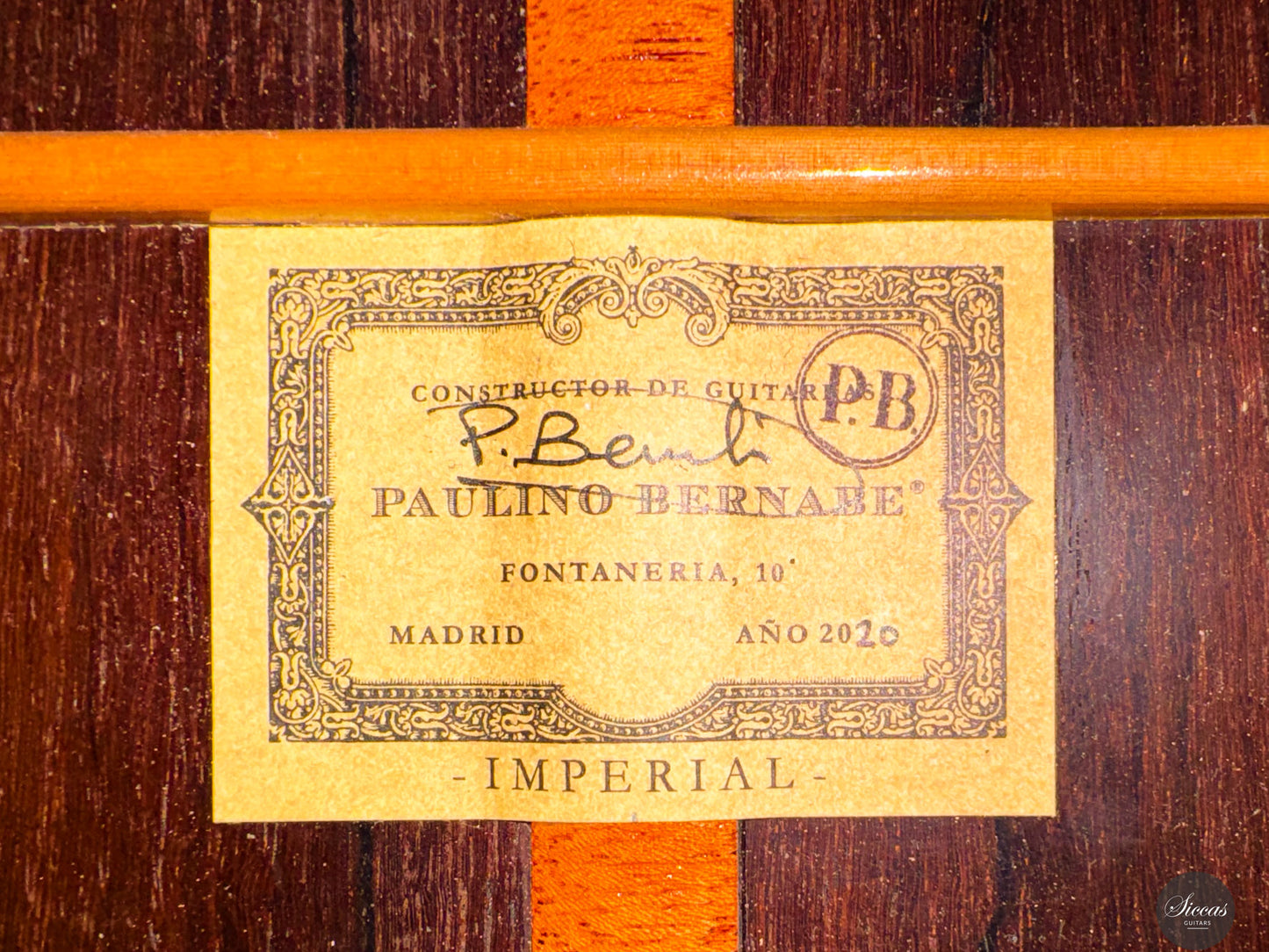Paulino Bernabe - 2020 - Imperial
Paulino Bernabe - 2020 - Imperial
Details
Details
Overview
Overview
Shipping important note
Shipping important note
Delivery times are typically reliable and most instruments arrive within the estimated timeframe.
Should any unexpected delay occur, our team will keep you informed and provide support at every step. For all shipping details and exceptions, please see our Shipping Policy.
Details about GPSR
Details about GPSR

























Video overview


More details about the guitar
About the luthier
Paulino Bernabé Sr. (* July 2, 1932 in Madrid, † May 10, 2007 in Madrid) ranks among the most distinguished Spanish luthiers of the twentieth century. After beginning his career in the 1950s in the workshop of José Ramírez III, he founded his own workshop in 1969. From the 1980s onward, he worked in close collaboration with his son, Paulino Bernabé Jr., who has continued and expanded the legacy. Bernabé guitars are known for their sophisticated craftsmanship and rich tonal palette and are played by numerous renowned artists, including Thibaut Garcia, winner of the 2016 Guitar Foundation of America competition.About the guitar
The 2020 Paulino Bernabé Imperial model represents the pinnacle of the workshop’s production, featuring the most carefully selected tonewoods and the highest level of craftsmanship. This guitar is built with a cedar top and Madagascar rosewood back and sides, delivering a dense, expressive tone with strong projection. The “X” bracing contributes to its immediate responsiveness and enhances the overall tonal richness. The low E resonance adds foundation to the bass register, while the trebles are bright and rounded, with enough headroom for dynamic shaping. Aesthetically and acoustically, this guitar stands as a concert-grade instrument, ideally suited for the demands of professional performance.Condition
As a pre-love instrument, this guitar is in excellent condition, showing only minimal playing wear.Regular care extends the life of the instrument
Even with careful use, a classical guitar may gradually change in appearance or respond to unstable storage conditions. Have a close look at your guitar regularly and be attentif to changes. If your instrument is suffering from its environement, it will let you know.
Protect Your Guitar: Handle with Care
Be mindful when touching your instrument with greasy or unwashed hands: any skin contact is a small attack on the varnish. Of course, a guitar is made to be played, but taking a few precautions helps preserve its beauty: wash your hands before playing, wear long sleeves, and avoid unnecessary direct skin contact with the body of the instrument.
Pro tip: Avoid playing with a button-up shirt, heavy jewelry, or a belt, as these can scratch the guitar. Also, make sure your guitar case is free of any objects that could damage the instrument during storage.
String care
A good habit to adopt is wiping down your strings briefly after each playing session. This small action significantly extends their lifespan and helps maintain a consistent, comfortable feel under your fingers.
Most importantly, clean strings are essential for keeping your instrument in tune. Corrosion, sweat, and dust can affect the uniformity of the strings and interfere with accurate tuning across the entire fingerboard.
Pro tip: If you're having trouble getting your guitar in tune, it might be time to change the strings. A useful test is to compare the pitch of the 12th fret harmonic with the fretted note at the 12th fret; if there's an unusually large gap between them, your strings may have lost their integrity and should be replaced.
Keep Your Shellac Finish Shining!
Got a guitar with a shellac (French polish) finish? Here's a simple trick: Take a clean microfiber cloth and gently breathe on the surface to create a light mist. Then, softly rub to remove fingerprints, sweat, and grease. That’s usually all it takes to keep it looking great, no products needed!
Pro tip: Every few years, treat your guitar to a check-up with a luthier to keep it in top shape.
Storing Your Guitar: Climate Matters
Your guitar can safely stay outside its case, as long as the surrounding environment maintains 42–55% humidity and a temperature between 18–25°C.
Keep in mind that humidity levels can still fluctuate inside the case, especially during seasonal changes.
- Too much humidity may cause overtightened strings and a dull tone.
- Too little humidity can lead to a bulging top, string buzz, or even cracks.
Avoid placing your guitar near radiators, air conditioners, or windows with direct sunlight.
Pro tip: Always close your guitar case while playing. This helps preserve a stable microclimate inside the case, so your instrument is protected the moment you put it back in.





















































